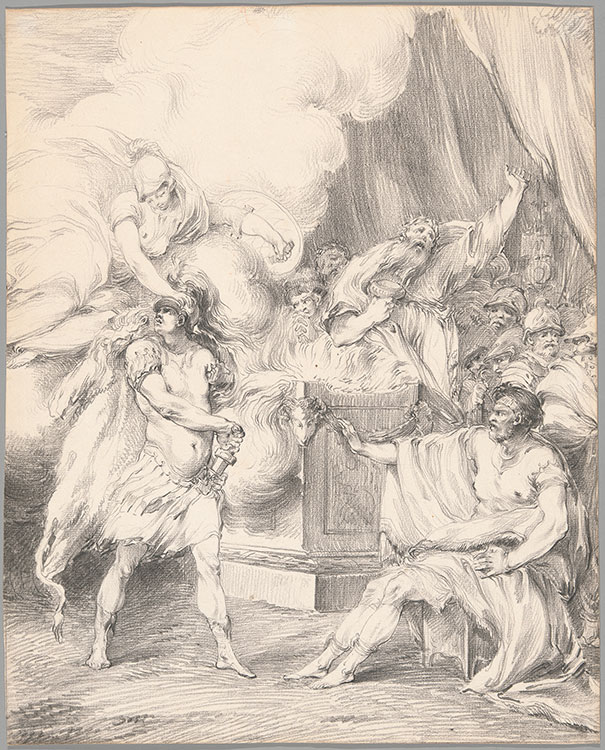
The Swedish draftsman and sculptor Johan Tobias Sergel trained with Pierre-Hubert L’Archevêque, a French artist active at the royal court in Stockholm. Later, Sergel spent several months studying at the Royal Academy in Paris. This early drawing reveals his resultant debt to French art, especially the light and sinuous graphic style of François Boucher (whose work appears elsewhere in the exhibition). The ambitious, highly theatrical composition illustrates a scene from Homer’s epic poem The Iliad. Seated at right, Agamemnon, the leader of the Greek army laying siege to Troy, agrees to return the abducted daughter of the Trojan priest Chryses, demanding in exchange Achilles’s favorite concubine. Furious at the idea, Achilles, seen at left, draws his sword but is held back by the apparition of the goddess Athena.
Johan Tobias Sergel
Swedish, 1740–1814
Achilles restrained by Athena in Agamemnon’s tent, from “The Iliad,” Book I, 1765–66
Black chalk
The Art Institute of Chicago, gift of Richard and Mary L. Gray; 2019.887
Gray Collection Trust, Art Institute of Chicago
Photography by Art Institute of Chicago Imaging Department
Jennifer Tonkovich: The second half of the 18th century witnessed an onslaught of political upheavals throughout Europe. It also brought an increasingly public role for women. Narrative subjects from Greek and Roman history were imbued with additional meaning in this mutable, increasingly politicized climate. Both Johan Tobias Sergal and Jacques-Louis David seized on subjects that juxtaposed the roles of men and women in moments of conflict. Sergal chose to depict Athena stopping Achilles' hand, the goddess preventing further bloodshed over the abduction of Achilles' daughter. A group of soldiers lurk behind Sergal's seated Agamemnon, reminding us of the simmering threat. David's sketch displayed nearby outlines a mob of battle-ready Sabine men openly wielding knives and shields. In the related painting, the Sabine women, torn by their divided loyalty, risk themselves and their children as they intervene between their tribe and their new families. The juxtaposition of these sheets, which bracket the French Revolution is telling. For Sergal divine intervention halts the impending attack. While for David, an ardent revolutionary, it is female citizens of the Roman Republic who heroically bring resolution to the conflict.
